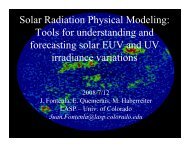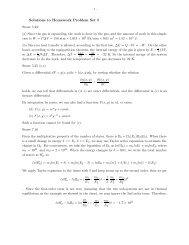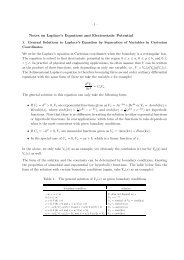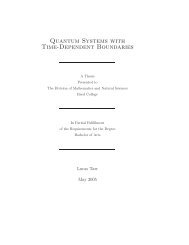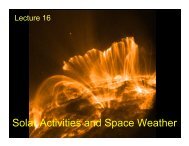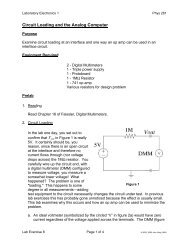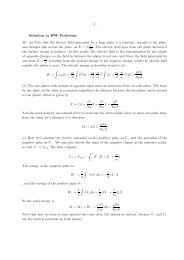312 Lab Manual - Solar Physics at MSU - Montana State University
312 Lab Manual - Solar Physics at MSU - Montana State University
312 Lab Manual - Solar Physics at MSU - Montana State University
Create successful ePaper yourself
Turn your PDF publications into a flip-book with our unique Google optimized e-Paper software.
The H-R Diagram<br />
•M<strong>at</strong>erials<br />
Computer Program: Microsoft Excel or<br />
equivalent<br />
•Introduction<br />
The purpose of this lab is to give you a hands<br />
(and computer) on experience with the<br />
Hertzprung-Russell, or H-R diagram. A simple<br />
review of its characteristics will be given. For<br />
more inform<strong>at</strong>ion, please consult your textbook.<br />
A basic knowledge of Microsoft Excel is helpful.<br />
•Basics: the H-R diagram<br />
The H-R diagram is a plot of the absolute magnitudes<br />
of stars, M, versus their spectral type.<br />
Sometimes you will see the y axis in units of<br />
solar luminosity, L o<br />
. Luminosity is directly proportional<br />
to absolute magnitude, and in this lab,<br />
we will use the absolute magnitudes of stars.<br />
Remember, the more neg<strong>at</strong>ive an absolute magnitude,<br />
the BRIGHTER the star. We will also be<br />
using the apparent magnitude, m, of stars. The<br />
apparent magnitude refers to how bright a star<br />
appears to us on Earth.<br />
The x axis, spectral type, is a measure of a star’s<br />
surface temper<strong>at</strong>ure. Astronomers label spectral<br />
type with integers and letters, ranging from<br />
M10 (cool, red), to O0 (hot, blue). Note th<strong>at</strong> a<br />
M7 type star is cooler than a M0 star, and th<strong>at</strong><br />
the order of letters from cool to hot is: M, K, G,<br />
F, A, B, O. The Sun is a G2 star with surface<br />
temper<strong>at</strong>ure of about 5800 K.<br />
•Basics: Luminosity classes<br />
In addition to classifying stars into spectral<br />
types, we group them into luminosity classes.<br />
A star with the temper<strong>at</strong>ure 5800 K might be a<br />
very luminous star (one with a neg<strong>at</strong>ive value<br />
of M), or a dim star (large, positive M). Astronomers<br />
give groups of stars with similar luminosities<br />
special names.<br />
For example, the brightest stars are called luminous<br />
supergiants and are labeled with the<br />
luminosity class Ia. The Sun is a main sequence<br />
star, class V. See the chart below for additional<br />
inform<strong>at</strong>ion.<br />
Luminosity Class<br />
Ia<br />
Ib<br />
II<br />
III<br />
IV<br />
V<br />
Star Type<br />
luminous supergiants<br />
less luminous supergiants<br />
bright giants<br />
giants<br />
subgiants<br />
main sequence<br />
•Basics: Plotting and using Excel<br />
Here are some tips and hints for plotting your<br />
d<strong>at</strong>a in Excel. The intent of these hints is not to<br />
teach you how to use Excel. If you have questions,<br />
see your instructor:<br />
1) Convert your x axis values to numbers. For<br />
example, set B=0, A=1, etc. Then you can use<br />
G2=3.2, or K1=4.1, and so on.<br />
2) In Excel, punch in your numbers for your x<br />
and y axis.<br />
3) Make a sc<strong>at</strong>ter plot, including axis labels.<br />
4) To get the correct y axis, with neg<strong>at</strong>ive values<br />
<strong>at</strong> the top, click on the y axis in the plot<br />
you’ve already cre<strong>at</strong>ed. Go to “Form<strong>at</strong>”, “Selected<br />
axis”, “Scale” tab. At the bottom, click<br />
“values in reverse order.”<br />
See your lab TA if you have questions.<br />
•Cre<strong>at</strong>e your H-R diagrams<br />
A) Main Sequence Stars<br />
Plot, in Excel or another graphing program, the<br />
stars in Table A. The curve th<strong>at</strong> approxim<strong>at</strong>ely<br />
connects these points is the main sequence;<br />
most stars lie on this line. As mentioned earlier,<br />
the main sequence stars are luminosity<br />
class V stars. Make a label in your plot th<strong>at</strong><br />
indic<strong>at</strong>es this fact.<br />
B) Giant Stars<br />
Now plot the stars in Table B on the same<br />
diagram. These are giant stars, luminosity<br />
class III.<br />
C) The Brightest stars in the sky<br />
In a new diagram, plot all of the stars from Table<br />
A and Table C. In Table C, the roman numerals<br />
refer to the luminosity class, as in the table<br />
above. “M” is absolute magnitude, and “m” is<br />
apparent magnitude.<br />
D) The Nearest stars in the sky<br />
In another new diagram, plot all of the stars<br />
in Table D.<br />
The H-R Diagram<br />
17



